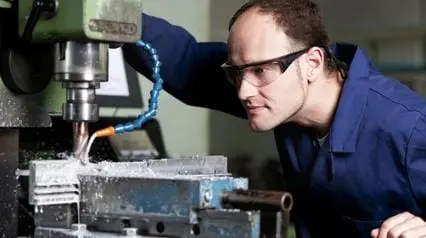What are Metalworking Fluids?
Metalworking fluids or MWFs refer to a range of oils and liquids used for metal workpieces and machinery. There are many applications of metalworking fluids such as lubricating parts, reducing heat and friction, and preventing burning and smoking when working with certain tools and machinery.
The primary goal of MWFs is to improve the quality of different metal machinery. With metalworking fluids, these machines work much smoother and more efficiently, which is why they are crucial in many workspaces.
What Are They Used For?
There are various types of metalworking fluids that have their own purpose. However, most of these fluids are designed and manufactured to lubricate and cool down different pieces of machinery. Essentially, MWFs increase the functionality of these machines and ensure that they work properly without overheating or breaking down because of a lack of lubrication or cooling.
You can find MWFs in many types of machinery, such as engines and manufacturing machines. That said, exposure to MWFs through skin contact or accidental inhalation can cause many dangers, which is why it’s essential to follow safety standards and best practices when working with MWFs.
Common Types of MWFs
There are various MWFs available today, each with its own unique uses. This section will briefly explain the most common types of MWFs that you will find in most machines.
Straight Oils
These oils are also called neat or cutting oils. Typically, they are made out of mineral (petroleum), animal, marine, vegetable, or synthetic oils. These oils are very refined to remove as many polynuclear aromatic hydrocarbons or PAHs. Generally, these oils aren’t diluted with water but contain other additives.
Soluble Oils
These oils contain between 35%-85% mineral oil. However, they are also equipped with different emulsifiers to make them dissolve in water.
Semi-Synthetic Fluids
These oils are comprised of 5%-30% refined petroleum oil with 30%-50% water and other additives.
Synthetic Fluids
These fluids do not contain any mineral or petroleum oil. Instead, they are made of a detergent-like material that will lubricate or “wet” the machinery or workpiece.
Each of these MWFs has its own unique composition. However, the majority of them also contain additional additives such as emulsifiers, sulfurized or chlorinated compounds, corrosion inhibitors, and more.
Safety Concerns When Working with MWFs
There are several health and safety concerns associated with MWFs. The most common of these concerns is contact dermatitis, which occurs when MWFs directly contact the skin and cause a reaction. Additionally, accidental inhalation of these MWFs can lead to asthma and lung irritations, which can be very dangerous for certain people.
Because of these concerns, there are various safety standards designed to make working around MWFs much safer for everyone involved.
Standards for Making MWFs Safer
The Occupational Health and Safety Association (OSHA) has established various standards to make it safer for people working with MWFs. Currently, there are standards around MWFs in place for general, maritime, and manufacturing industries.
These standards cover all the basic hazards of working with MWFs. Particularly, these standards deal with potential skin contact and inhalation of MWFs. They are specifically designed to reduce the chances of incidents with MWFs occurring and to increase the overall safety of the workplace.
Other countries have also set their own safety standards for working with metalworking fluids. For example, the UK’s Health and Safety Executive (HSE) follows the Control of Substances Hazardous to Health (COSHH) regulations.
FAQs about Metalworking Fluids
The most common type of metalworking fluid is known as a coolant. These fluids are specifically designed to keep different parts of a machine cool and lubricated, allowing for smoother operations. These fluids are typically oil emulsified in water, which means they are typically classified as soluble oils or semi-synthetic fluids.
Metalworking fluids may have a significant effect on water quality. In soft water, MWFs can increase foaming. And in hard water, MWFs may result in the formation of lime and calcium, lesser corrosion protection, and shorter sump life.
Skin contact with MWFs can cause skin irritation, which is the most common safety concern when dealing with these fluids. Thus, it’s important to reduce the chances of making contact with chemical hazards like MWFs.
When working with MWFs, it’s important to follow proper safety standards to protect all workers and ensure compliance. To do this, it would be helpful to use various tools that you can use to train employees, establish workflows around the applicable safety standards, and check on whether or not employees follow these standards.




